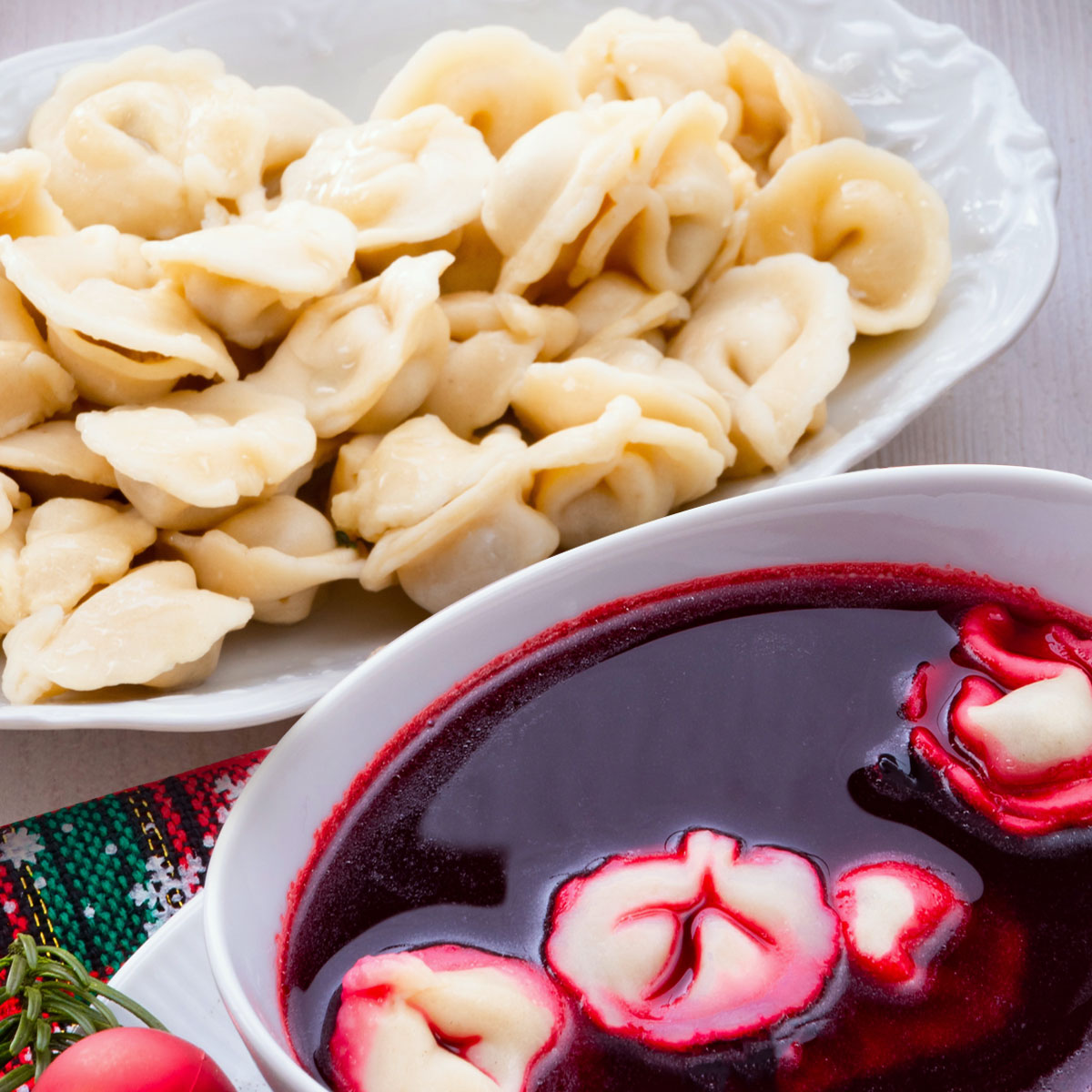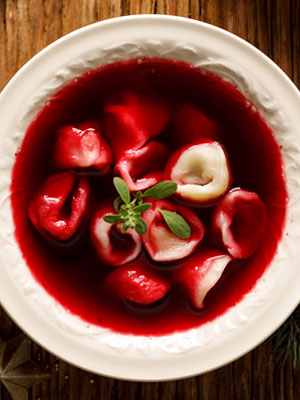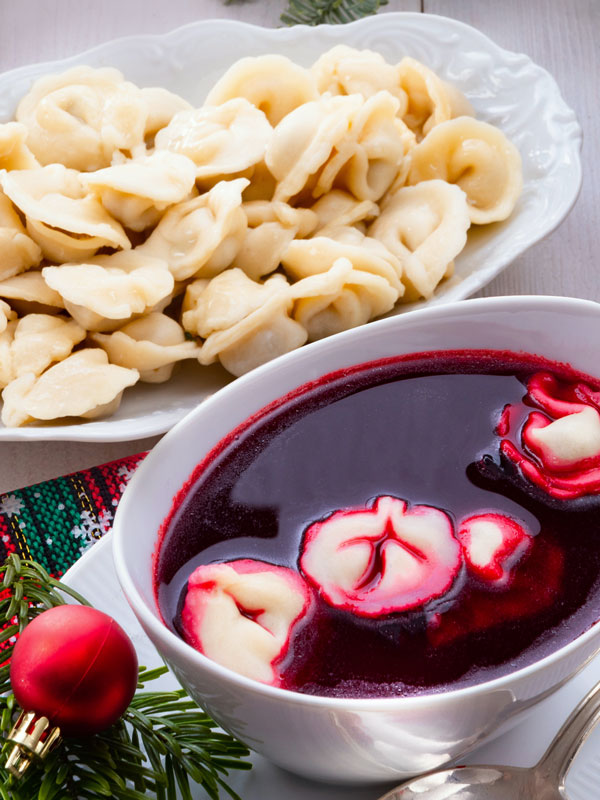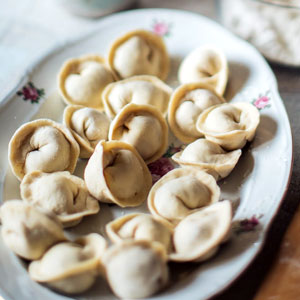Wigilijne Uszka z Grzybami
Uszka: Polish Christmas Dumplings (for Barszcz)
How to pronounce it?
oosh-kah
‘Play’ to hear:

Uszka (literally ‘Little Ears’, already plural) are tiny Polish dumplings, shaped like… little ears, hence the name.
On Christmas Eve, they’re traditionally stuffed with Wild Mushroom or Sauerkraut filling (sometimes a mix of both) and are served in a clear Red Barszcz soup.
For the full list of ingredients & detailed instructions, please see the recipe card at the end of this post. But before you scroll, there’s important stuff to know below.
In this recipe, we’ll be making the former – festive Uszka packed with fragrant porcinis (penny buns). If you can’t find these mushrooms – don’t worry, just read on.
Do you need any special ingredients to make these Uszka dumplings?
Yes, and sadly – the key ingredient can be pricey (unless you’re a mushroom forager yourself).
🇵🇱 In Poland, mushroom hunting is a very popular autumn pastime. Even if you don’t participate, there’s always someone in the family or friend circle who does.
In season, fresh wild fungi (porcini/boletus; bay boletus and many more) are available at farmer’s markets and produce stalls. You’ll find them dried or frozen throughout the year at any larger supermarket.
🌍 Internationally, mushroom foraging often proves difficult. Forests are often private and entrance is restricted. Fungi species differ geographically as well.
Dried and frozen wild mushrooms are great, you’ll find them in larger supermarkets and online (here’s a pack from Amazon). You can cheat a bit by adding cheaper, more accessible champignons.
This post contains affiliate links: Find out what that means.
How should you serve these Uszka?

Mushroom-filled Uszka are traditionally served with a Red Borscht soup. (👈 click for a recipe)
You can also serve them the same way as Italian tortellini – with toppings, sauces and garnishes of your choice.
Can you make these Uszka another way?
You can use another filling. For Christmas, it’s mostly mushroom or sauerkraut (or a mixture of both), but it can be anything. Check out his Pierogi Filling ideas for some inspiration.
Another thing you could do differently is to use caramelized onions, if you make them in advance.
What diets are these Uszka dumplings suitable for?
These Uszka are suitable for vegans.
If you follow a gluten-free diet, try replacing the dough with this Gluten-free Pierogi Dough recipe.
Can I freeze these Uszka?
Yes, you can, here’s how:
Grease a tray with some oil and place the dumplings on top. Make sure they don’t touch each other. Place the tray in the freezer for 2 hours.
After that time, move Uszka into a freezer-friendly container or a bag. Remember to label it with date and description. Consume within 2-3 months. Thaw overnight in the fridge.

Uszka: Polish Christmas Dumplings / Mini Pierogi for Red Borscht (Vegan)

These classic 'Uszka' are PACKED with wild mushrooms. They pair beautifully with Clear Beet Borscht.
Ingredients
For Wild Mushroom Filling
- 1 oz (30 g) dried porcinis or bay boletes (Polish ‘borowik’ and ‘podgrzybek’ respectively)
- 1 cup water
- 1 medium (6 oz, 175 g) onion
- 0.5 lb (230 - 250 g) chestnut mushrooms, fresh
- 1 tbsp oil, e.g. canola
- 1 garlic clove
- 1 tsp dried thyme
- Salt and freshly ground black pepper, for seasoning
- 3-4 tbsp white dry wine, can substitute for water
- 1 tbsp parsley, finely chopped
For 'Uszka' Dough
- 2.5 cups (300 g) all-purpose flour
- 0.5 tsp salt
- 1 tbsp olive or canola oil
- ⅘ cup (200 ml) hot water
Instructions
For the filling:
- Pour a glass of water over the dried porcinis and cook over a low heat for 30 minutes. (This can be done in advance e.g, a day before.).
- Once that’s done, it’s worth keeping the remaining ‘mushroom water’; it’s useful in flavouring other dishes such as stews and soups. Keep it refrigerated or freeze it.
- Peel the onion, slice it finely. Do the same with chestnut mushrooms and cooked porcinis.
- Heat up a tablespoon of oil in a frying pan. Sauté finely chopped onion for a few minutes over a medium heat, until it turns translucent.
- Add minced garlic clove and continue frying for another 30 seconds, stirring along the way. Add all the mushrooms we chopped, together with a teaspoon of dried thyme and a pinch of nutmeg. Season with salt and pepper.
- Reduce the heat to ‘low’ and cook the mushrooms gently, stirring occasionally. Mushrooms will release their juices first, and then they’ll evaporate.
- As the pan gets dry, add in 3 to 4 tablespoons of white wine, increase the heat to ‘medium-high’ and continue cooking until the wine evaporates completely. Make sure to stir from time to time, so that nothing sticks too badly to the pan.
- Have a taste - does it need more seasoning? If so, add a bit more salt and pepper. Add finely chopped parsley leaves.
- To make ‘Uszka’ assembly a bit easier, it’s worth grinding down the filling even more. You can use an immersion (hand-held) blender, or just chop everything again with a knife.
- I enjoy a little bit of texture in the filling, so I divide the mass into two. I leave one part as-is (straight off the pan) and grind the other part with a blender into a smooth paste. Then I combine the two.
- Store the mushroom filling in the fridge, until you’re ready to assemble the dumplings.
For the dough:
- Sift the flour and salt into a large bowl. Pour in a tablespoon of oil.
- Gradually pour hot water into the flour, mixing with a spoon as you go.
- Dust your work surface with flour. Move the dough ball onto it.
- Knead the dough until soft and smooth.
- Form a ball, cover it with a kitchen cloth and set aside to rest.
Assembly:
- Sprinkle the worktop with flour. Divide the dough into four parts. Roll each part (keeping the rest covered) into a thin layer of dough - like super-thin! 0.04-0.08 in (1-2 mm).
- Using a rim of a small glass (or a round cookie cutter), cut out circles from the dough.
- In the center of the cut circle, put about half a teaspoon of the filling and glue it together, forming a crescent (just like for pierogi).
- Then connect both ends to form a ring - it's best to wrap the dumpling around your little finger and stick the ends together. If it’s not sticking, wet the ends with a tiny bit of water.
- Place the ready-made ‘Uszka’ on a pastry board or your work surface, sprinkled with flour. Cover them with a cloth until you’re ready to cook them all.
Cooking:
- Prepare a pot of boiling water and salt it generously. Throw in a few 'Uszka' dumplings at a time, but not too many - so that they don't lower the water temperature significantly.
- After throwing them into the water, stir the dumplings very gently. We don’t want them to stick to the bottom.
- Once the dumplings start to float, continue cooking for another minute.
- Using a slotted spoon, retrieve cooked ‘Uszka’ and place them on a plate - but make sure they don’t touch each other (they tend to stick).
- Once they cool ever-so-slightly, serve them in your borscht. Otherwise, wait for them to cool completely and move into a container with a lid, then refrigerate.
Notes
Ideally, the water should be very hot - that way gluten gets a kick to develop. I just leave the boiled water in the kettle for 3-5 minutes, giving them a chance to cool it down a bit.
Polonist is reader-supported. When you buy through links on our site, we may earn a small affiliate commission. Learn more
Recipe Information
Filed under:
Alternative traditional/regional names:
Uszka z Farszem Grzybowym
Also known / Misspelt internationally as:
Mini Pierogi, Polish Ravioli, Polish Tortellini, Kreplech, Kreplach
Tested by:
First published on:
Recipe by / Adapted from:
Story by:
Bibliography / References: